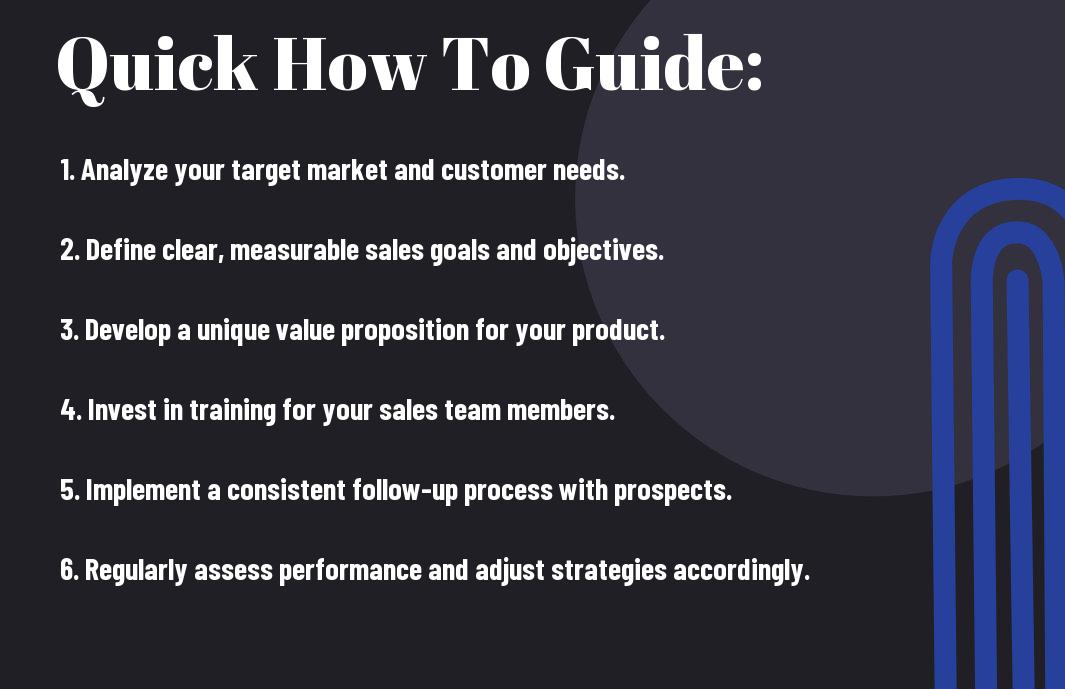
Sales success doesn’t happen by chance; it requires a well-structured strategy that aligns with your business goals and understands your customers’ needs. In this guide, you’ll discover key steps to create an effective sales strategy that not only boosts immediate results but also lays the groundwork for sustainable growth. By leveraging market insights and refining your approach, you can enhance your sales performance and build lasting relationships with your clients.

Understanding the Sales Landscape
Before plunging into your sales strategy, it’s vital to gain a comprehensive understanding of the sales landscape. This means familiarizing yourself with the various elements that influence buyer behavior, competitor movements, and the overall market dynamics. A thorough grasp of these factors will better equip you to craft a sales approach that resonates with your audience and stands the test of time.
Analyzing Market Trends
If you want to stay ahead of the competition, you must systematically analyze market trends. This involves monitoring shifts in consumer preferences, economic indicators, and technological advancements that could impact your industry. By staying informed on these trends, you can adapt your sales strategy accordingly and position your offerings more effectively in the marketplace.
Identifying Target Customers
Assuming you have a general idea of your market, the next step is to identify your target customers. This means digging deeper to understand who your ideal buyers are, including their demographics, purchasing habits, and preferences. Gaining clarity on this aspect enables you to tailor your sales approach and messaging directly to their needs, making your efforts more effective.
Identifying your target customers involves gathering data through various means, such as surveys, interviews, and market research. You should develop detailed customer personas that outline not only who your ideal buyers are but also what motivates them to make a purchase. This helps you build tailored messaging and ensure that you are addressing their pain points directly, ultimately leading to increased engagement and conversions.
Key Factors in Sales Strategy Development
If you want to create a successful sales strategy, focus on these key factors:
- Understanding your target market
- Establishing a unique selling proposition (USP)
- Setting clear objectives
- Evaluating resources and capabilities
- Monitoring performance and making adjustments
Knowing these factors will help you lay a strong foundation for long-term success.
Setting Clear Objectives
On your journey to build an effective sales strategy, it’s important to set clear and measurable objectives. Having defined targets not only guides your efforts but also provides a benchmark against which you can evaluate your progress. Ensure your objectives align with both your overall business goals and the specific needs of your market.
Evaluating Resources and Capabilities
Factors to consider when evaluating your resources and capabilities include your team’s skills, technology, and available budget. Assessing these elements allows you to identify strengths and weaknesses, enabling you to optimize your sales approach effectively. By understanding where you excel and where you need improvement, you can allocate resources more strategically.
Resources play a significant role in the effectiveness of your sales strategy. Make sure to analyze the skills and expertise of your sales team, available technology, and financial resources that can support your deployment efforts. Recognizing gaps in these areas allows you to invest in training, tools, or personnel that could enhance your productivity and drive success. Prioritizing resource allocation ensures you will maximize your efforts in reaching sales goals.
Crafting an Effective Sales Message
Not all sales messages resonate equally with your audience. To truly connect and inspire action, you’ll need to craft a message that is compelling, clear, and focused on addressing your customers’ specific needs and pain points. This means not only highlighting what you offer but doing so in a way that aligns with your audience’s values and perspectives. Tailoring your approach and understanding the emotional triggers at play will take your sales efforts to the next level.
Building Value Propositions
Clearly defining your value proposition is imperative for establishing why your product or service stands out in the marketplace. This statement should highlight the unique benefits you offer to customers, framing your solution as the best answer to their problems. Articulating this effectively will not only capture attention but also build trust and credibility, ensuring your audience perceives your offering as a worthy investment.
Tailoring Messages for Different Audiences
Some audiences respond better to specific types of messaging, which requires you to adapt your sales message based on the interests and needs of different segments. Whether you are addressing decision-makers, end-users, or influencers, each group has unique perspectives that dictate how they perceive value. By customizing your communication, you enhance engagement and drive more meaningful connections.
Messages should be carefully crafted to address the specific concerns and interests of each audience segment. For example, executives might focus on ROI and efficiency, while end-users may prioritize usability and support. By aligning your messaging with their expectations, you demonstrate that you understand their unique challenges, making them more likely to engage and take action. This tailored approach not only helps you stand out in a crowded marketplace but also fosters long-lasting relationships with diverse customer segments.
Developing a Sales Plan
After identifying your target market and understanding their needs, it’s time to create a comprehensive sales plan. This plan should outline your sales objectives, strategies, and tactics to effectively reach potential customers. Focus on creating a roadmap that aligns with your overall business goals while addressing key sales challenges. By defining clear action items and deadlines, you’ll be able to stay organized and adapt to any changes in the market landscape.
Implementing Actionable Steps
Implementing actionable steps is vital to translating your sales plan into reality. Break down your objectives into manageable tasks, assigning responsibilities to your sales team. Establish a timeline for each action item and prioritize tasks based on their impact. This structured approach will help you stay on track while ensuring everyone contributes to the plan’s success.
Establishing Metrics for Success
Assuming you want to measure the effectiveness of your sales strategy, establishing metrics for success is vital. These metrics should reflect your sales goals and provide insights into your team’s performance. Examples include tracking lead conversion rates, average deal size, and customer retention rates. By analyzing this data, you can identify areas for improvement and adjust your tactics to enhance overall effectiveness.
Steps to establish metrics for success involve first defining what outcomes are most important for your business. Next, select key performance indicators (KPIs) that align with those outcomes, ensuring they are Specific, Measurable, Achievable, Relevant, and Time-bound (SMART). Regularly review these metrics and conduct performance assessments to refine your sales approach, creating a continuous improvement cycle that drives results over time.
Training and Empowering Sales Teams
Many successful organizations prioritize training and empowering their sales teams, recognizing that a well-prepared team significantly impacts overall performance. By providing your sales staff with the right training and resources, you enable them to develop crucial skills, stay updated on industry trends, and enhance their confidence. This investment in your team fosters a culture of continuous improvement, ensuring that they not only meet but exceed sales targets consistently.
Providing Ongoing Education
You should make ongoing education a standard practice within your sales team. This can include workshops, webinars, and access to online courses that keep them informed about product knowledge, sales techniques, and market trends. Consistent education not only sharpens their skills but also motivates them to excel in their roles, positioning your organization for sustained success.
Integrating Technology and Tools
Any effective sales strategy must leverage technology and tools to maximize efficiency and streamline processes. Utilizing customer relationship management (CRM) systems, data analytics, and communication platforms allows your team to track leads, manage customer interactions, and collect valuable insights. By integrating these technologies, you empower your sales team to focus on building relationships and closing deals, rather than getting bogged down by administrative tasks.
A comprehensive suite of tools enhances your sales team’s ability to connect with clients effectively. With robust CRM systems, your team can maintain detailed records of customer interactions, preferences, and purchase histories, enabling personalized selling approaches. Additionally, using data analytics tools empowers your sales team to identify trends and customer needs, allowing for more strategic decision-making. Embracing technology not only boosts productivity but also fosters a more dynamic and responsive sales environment.
Tips for Continuous Improvement
Your sales strategy should never be a static document. To thrive, you must prioritize ongoing refinement and evolution. Consider implementing these practices:
- Regularly assess sales performance metrics
- Encourage team collaboration and idea-sharing
- Invest in training and development
- Stay updated on industry trends
Recognizing the importance of adaptability will ensure your strategy remains effective over time.
Gathering Feedback and Adjusting Strategies
An vital part of maintaining a successful sales strategy is actively gathering feedback from your team and clients. Use surveys and one-on-one conversations to understand their perspectives. Analyze this data to identify areas for improvement and adjust your strategies accordingly, ensuring they remain relevant to your market’s needs.
Staying Ahead of Competitors
Tips for staying ahead of competitors include conducting thorough market analysis and learning from their successes and failures. Regularly monitor innovations and trends within your industry to adapt your sales approach proactively. This allows you to refine your unique selling propositions and better meet customer demands.
Strategies for staying ahead involve regularly evaluating your competitors, understanding their tactics, and leveraging your strengths. Consider adopting new technologies or marketing strategies before your competitors do, which could give you a significant advantage. By fostering a culture of innovation within your team, you can position yourself as a leader in your industry.
To wrap up
Upon reflecting, developing a winning sales strategy for long-term success involves a clear understanding of your market, consistent engagement with your customers, and a commitment to adapting your approach based on performance metrics. You should prioritize building relationships and leveraging technology to streamline your processes. By continuously refining your tactics and embracing change, you position yourself for sustainable growth and heightened customer loyalty in a competitive landscape.
Leave a Reply